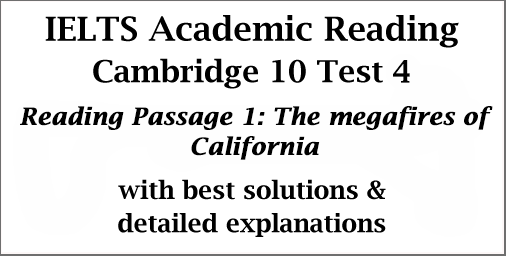IELTS Academic Reading: Cambridge 10 Test 4; Reading passage 1; The megafires of California; with best solutions and explanations
This IELTS Academic Reading post focuses on the solutions for IELTS Cambridge 10 Test 4 Reading Passage 1 which is entitled ‘The megafires of California’. This is a solution post for candidates who have big difficulties finding Reading Answers. This post can direct you to the best to comprehend every Reading answer easily. Finding IELTS Reading answers easily is a gradual process that needs attention and a good habit of reading and I hope this post can help you in this respect.

IELTS Cambridge 10 Test 4: AC Reading Module
Reading Passage 1:
The headline of the passage: The megafires of California
Questions 1-6: (Completing notes with ONE WORD AND/OR A NUMBER):
In this type of question, candidates are asked to write only word and/or a number to complete some notes on the given topic. For this type of question, first skim the passage to find the keywords in the paragraph concerned with the answer, and then scan to find the exact word.
[TIPS: Here scanning technique will come in handy. Target the keywords of the questions to find the answers. Remember to focus on Proper nouns, random Capital letters, numbers, special characters of text, etc.]
Questions 1 and 2: Characteristics of wildfires and wildfire conditions today compared to the past:
– Occurrence: more frequent
– Temperature: hotter
– Speed: faster
– Movement: 1 ____________ more unpredictably
– Size of fires: 2 ____________ greater on average than two decades ago.
Question 1: Movement: ____________ more unpredictably
Keywords for the question: movement, more unpredictably
Read the last lines of paragraph no. 1. “The wildfires themselves, experts say, are generally hotter, faster, and spread more erratically than in the past.” Here, erratically means unpredictably.
So, the answer is: spread
Question 2: Size of fires: ____________ greater on average than two decades ago.
Keywords for the question: size of fire, greater, than two decades ago
The first lines of paragraph no. 2 give us the answer. ““Megafires, also called ‘siege fires’ are the increasingly frequent blazes that burn 50,000 acres or more – 10 times the size of the average forest fire of 20 years ago.
Here, 20 years ago means two decades ago.
So, the answer is: 10/ten times
Questions 3-6:
Reasons wildfires cause more damage today compared to the past:
– Rainfall: 3 _________ average
– More brush to act as 4 __________
– Increase in yearly temperature
– Extended fire 5 __________
– More building of 6 __________ in vulnerable places
Question 3: Rainfall: _________ average
Keywords for the question: rainfall, average
We can find the keyword ‘rainfall’ in paragraph no. 3 but the word is not present there directly. We can see a synonym of ‘rainfall’ in line no. 4. Let’s read lines 1-4 of paragraph no. 3. “One explanation for the trend to more superhot fires is that the region, which usually has dry summers, has had significantly below normal precipitation in many recent years.”
Here, the words ‘precipitation’ means ‘rainfall’, ‘normal’ means ‘average’.
So, the answer is: below
Question 4: More brush to act as __________
Keywords for the question: more brush, act as,
Read lines 9-11 of paragraph no. 3, where the author says, “The unintentional consequence has been to halt the natural eradication of underbrush, now the primary fuel for megafires.” These lines mean that previously US Forest Service had a policy to cut down (eradication) the underbrush regularly because it was the main reason (primary fuel) for forest fires. But now the service is at halt (stop). So, more underbrush is growing more and more and it is acting as the fuel for megafires.
So, the answer is: fuel
Question 5: Extended fire __________
Keywords for the question: extended fire
In paragraph no. 4 the author mentions three other factors of megafires. Take a look at the second factor in lines 5-7, “. .. . Second is fire seasons that on average are 78 days longer than they were 20 years ago.”
Here, 78 days longer than they were 20 years ago = extended
So, the answer is: seasons
Question 6: More building of __________ in vulnerable places
Keywords for the question: more building, vulnerable places,
Again, in paragraph no. 4 the author mentions three other factors of megafires. Take a look at the third factor in lines 7-9, “Third is increased construction of homes in wooded areas.”
As we know, wood is vulnerable/ risky for catching fire, here wooded areas means vulnerable places. Also, increased construction means more building.
So, the answer is: homes
Questions 7-13: TRUE, FALSE, NOT GIVEN
In this type of question, candidates need to find out whether:
The statement in the question matches with the account in the text- TRUE
The statement in the question contradicts the account in the text- FALSE
The statement in the question has no clear connection with the account in the text- NOT GIVEN
[For this type of question, you can divide each statement into three independent pieces and make your way through with the answer.]
Question 7: The amount of open space in California has diminished over the last ten years.
Keywords for the question: amount of open space, California, diminished, last ten years
Lines 1-7 of paragraph no. 6 give the answer. “In California, where population growth has averaged more than 600,000 a year for at least a decade, more residential housing is being built. What once was open space is now residential homes providing fuels to make fires. .. . .”
The lines suggest that California has a big population growth (600,000 every ten years/decade) and more residential houses has been built. So, open spaces have been occupied by residential homes which means the amount of open space has diminished (decreased).
So, the answer is: TRUE
Question 8: Many experts believe California has made little progress in readying itself to fight fires.
Keywords for the question: many experts, California, little progress, fight fires,
At the beginning of paragraph 7, the writer mentions, “That said, many experts give California high marks for making progress on preparedness in recent years, after some of the largest fires in state history scorched thousands of acres, burned thousands of homes, and killed numerous people.”
The lines suggest that experts believe that California should get high marks or praise for the progress in preparedness in firefighting. So, the question contradicts the information in the passage.
Here, the phrase ‘readying itself’ means ‘preparedness’.
So, the answer is: FALSE
Question 9: Personnel in the past have been criticised for mishandling fire containment.
Keywords for the question: personnel, criticised, mishandling, fire containment,
In the final half part of paragraph 7, the author talks about the criticism, “Stung in the past by criticism of bungling that allowed fires to spread when they might have been contained, personnel are meeting the peculiar challenges of neighborhood – and canyon – hoping fires better than previously, observers say.”
Here, stung in the past by criticism = criticised, bungling = mishandling, they might have been contained = fire containment,
So, the answer is: TRUE
Question 10: California has replaced a range of firefighting tools.
Keywords for this question: replaced, firefighting tools,
In paragraph 9, the writer starts by saying, “Besides providing money to upgrade the fire engines that must traverse the mammoth state and wind along serpentine canyon roads, the state has invested .. .. .” These lines suggest to the fact that the State of California has invested money to upgrade (replace) its firefighting engines or tools.
So, the answer is: TRUE
Question 11: More firefighters have been hired to improve fire-fighting capacity.
Keywords for this question: more firefighters, hired, improve, fire-fighting capacity,
In this passage, we find the writer mentioning the upgrading of firefighting engines or tools, but there is no mention of whether more firefighters have been hired to improve fire-fighting capacity.
So, the answer is: NOT GIVEN
Question 12: Citizens and government groups disapprove of the efforts of different states and agencies working together.
Keywords for this question: citizens and government groups, disapprove, states and agencies, working together,
Take a look at the end of paragraph 9, where the writer states, “There is a sense among both government and residents that the speed, dedication, and coordination of firefighters from several states and jurisdictions are resulting in greater efficiency than in past ‘siege fire’ situations.”
The lines clearly suggest that both citizens (residents) and government groups approve or support the efforts of different states and agencies (jurisdictions) working together (coordination). So, the statement in the passage contradicts with the question.
So, the answer is: FALSE
Question 13: Randy Jacobs believes that loss of life from fires will continue at the same levels, despite changes made.
Keywords for this question: Randy Jacobs, loss of life, same levels,
We find the comments of Randy Jacobs at the very end of the passage who says, “Notwithstanding all the damage that will continue to be caused by wildfires, we will no longer suffer the loss of life endured in the past because of the fire prevention and firefighting measures that have been put in place”.
This means as a result of the fire prevention and firefighting measures, citizens of California will no longer suffer the loss of life from fires like they did in the past. So, the statement clearly contradicts the given question.
So, the answer is: FALSE
Click here for solutions to Cambridge 10 Test 4 Reading Passage 2
Click here for solutions to Cambridge 10 Test 4 Reading Passage 3




I’m a beginner
AMAZING
bangladeshsd